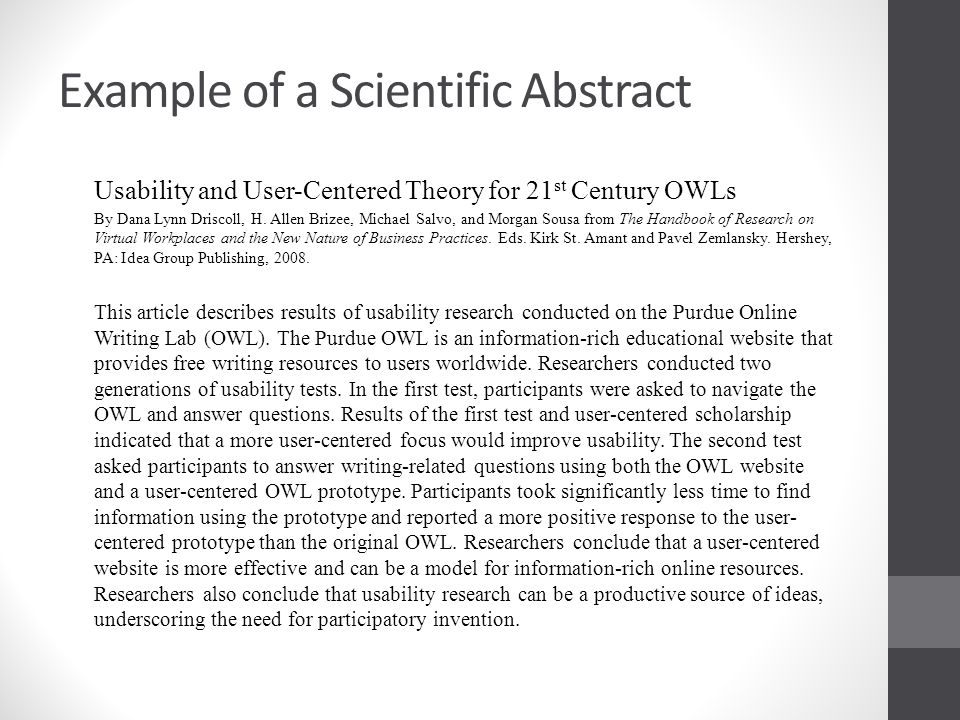
What is a Thesis or Dissertation Abstract?
· 4. Write your scientific abstract in a formal and unadorned style. Occasionally, guidelines for scientific abstracts will request a less formal, point-form style, but abstracts for most publishers and instructors will require complete sentences and language equivalent to that in the research document itself · Write the word “Abstract” at the top of the page, centered and in a bold font. Don’t indent the first line. Keep your abstract under words. Include a running header and page numbers on all pages, including the abstract. Abstract keywords have their own particular guidelines as well: Label the section as “ Keywords: ” with italics · Abstracts should be written after the full paper is written, and are usually about words and one to two paragraphs long. An abstract should include a statement of the problem you are trying to solve and the purpose of your research, the methods used to find the solution, the results and the implications of your findings
What is the Purpose of an Abstract?
· Write the word “Abstract” at the top of the page, centered and in a bold font. Don’t indent the first line. Keep your abstract under words. Include a running header and page numbers on all pages, including the abstract. Abstract keywords have their own particular guidelines as well: Label the section as “ Keywords: ” with italics · Pick a scientific article in your field. Read the paper with the abstract covered. Then try to write an abstract based on your reading. Compare your abstract to the author’s. Repeat until you feel confident. If you’ve not yet published a paper, this exercise will help you hone the skills necessary to write a concise and informative blogger.comted Reading Time: 6 mins It goes without saying that whatever is present in the abstract must also be present in the text. Likewise, whatever errors should not be made in the text should not appear in the abstract (eg, mistaking association for causality). As already mentioned, the abstract is the only part of the paper that the vast majority of readers see

Browse more articles
It goes without saying that whatever is present in the abstract must also be present in the text. Likewise, whatever errors should not be made in the text should not appear in the abstract (eg, mistaking association for causality). As already mentioned, the abstract is the only part of the paper that the vast majority of readers see · Abstracts should be written after the full paper is written, and are usually about words and one to two paragraphs long. An abstract should include a statement of the problem you are trying to solve and the purpose of your research, the methods used to find the solution, the results and the implications of your findings · Write the word “Abstract” at the top of the page, centered and in a bold font. Don’t indent the first line. Keep your abstract under words. Include a running header and page numbers on all pages, including the abstract. Abstract keywords have their own particular guidelines as well: Label the section as “ Keywords: ” with italics
INTRODUCTION
An abstract is a short summary of your (published or unpublished) research paper, usually about a paragraph (c. sentences, words) long. A well-written abstract serves multiple purposes: an abstract lets readers get the gist or essence of your paper or article quickly, in order to decide whether to read the full paper; · Abstracts should be written after the full paper is written, and are usually about words and one to two paragraphs long. An abstract should include a statement of the problem you are trying to solve and the purpose of your research, the methods used to find the solution, the results and the implications of your findings · Write the word “Abstract” at the top of the page, centered and in a bold font. Don’t indent the first line. Keep your abstract under words. Include a running header and page numbers on all pages, including the abstract. Abstract keywords have their own particular guidelines as well: Label the section as “ Keywords: ” with italics

Abstract example
· Abstracts should be written after the full paper is written, and are usually about words and one to two paragraphs long. An abstract should include a statement of the problem you are trying to solve and the purpose of your research, the methods used to find the solution, the results and the implications of your findings An abstract is a short summary of your (published or unpublished) research paper, usually about a paragraph (c. sentences, words) long. A well-written abstract serves multiple purposes: an abstract lets readers get the gist or essence of your paper or article quickly, in order to decide whether to read the full paper; · Pick a scientific article in your field. Read the paper with the abstract covered. Then try to write an abstract based on your reading. Compare your abstract to the author’s. Repeat until you feel confident. If you’ve not yet published a paper, this exercise will help you hone the skills necessary to write a concise and informative blogger.comted Reading Time: 6 mins
No comments:
Post a Comment